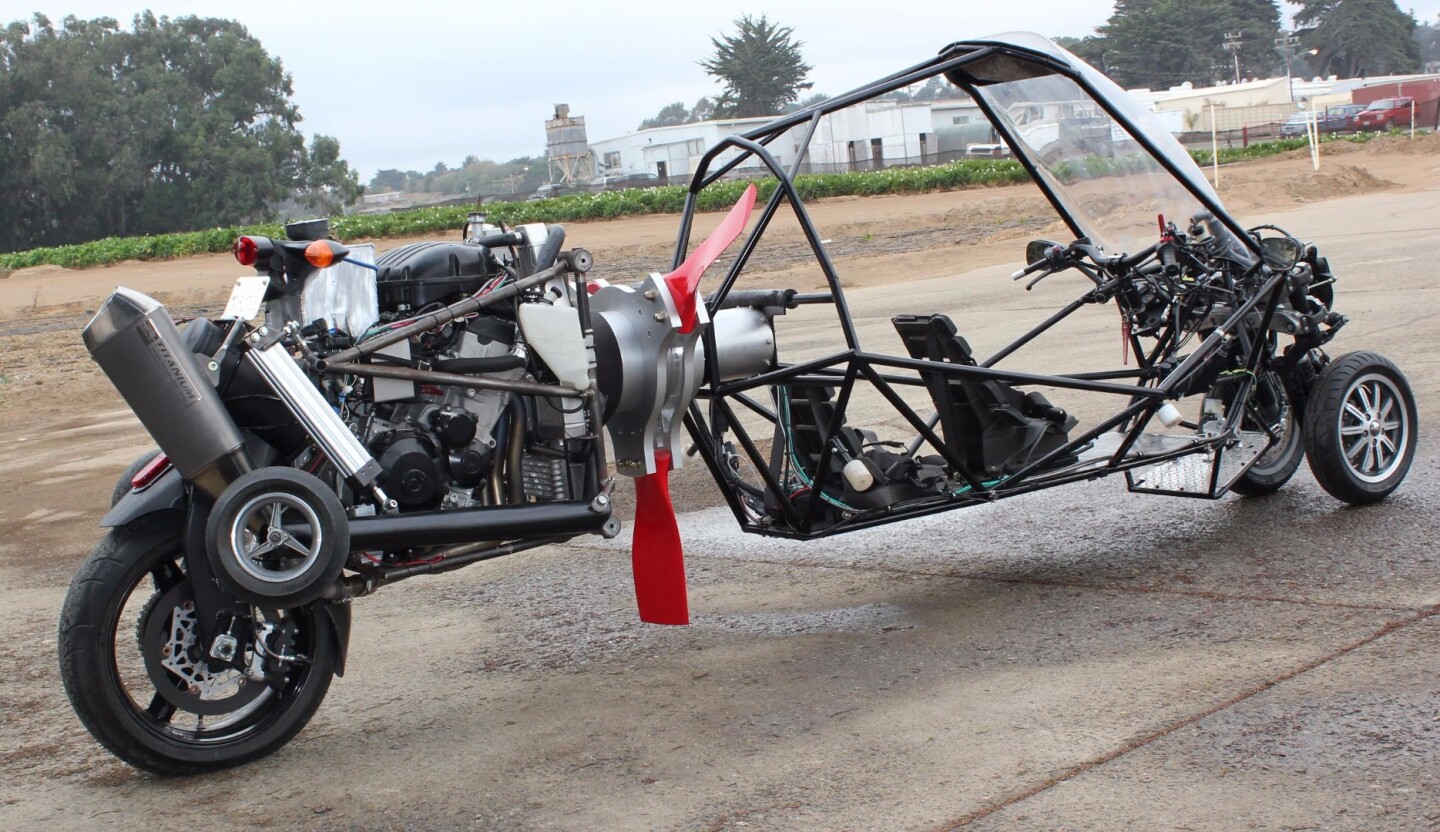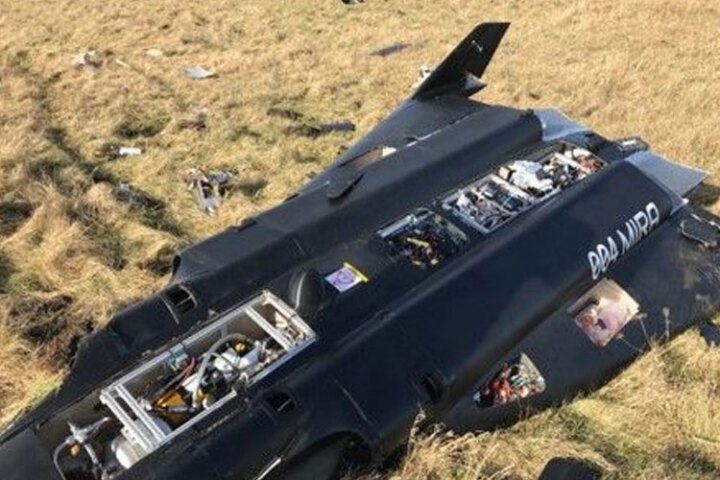In part four of our extended interview with serial inventor and flying car advocate Dezso Molnar, Dezso puts his money where his mouth is. After giving us his philosophy on flying cars, and reviewing his favorite and least favorite existing designs, Dezso speaks about the two flying car designs he's currently working on as he prepares to launch the world's first flying car race series. The Street Wing concept is a fully electric, solar-supported streetable airplane, and the G2 Gyrocycle is a race-focused, 200 mph three-wheeler that's already rolling on the street, and nearly ready to fly.
The Street Wing electric flying car
For the electric, I call it the Street Wing. Because of the power loading requirements of gyroplanes and quadcopters and vertical takeoff, I'm focusing on an aircraft with wings and best possible range.
It's going to be a trike, which fits the motorcycle category on the ground. You'll be able to drive it down the street no problem. It'll have steering front wheels, which harkens back to the Zuck Planemobile. So the front wheels steer and the rear wheel is powered and rigid in its alignment.
When you're driving, that allows you to steer down the road and have stable control as opposed to one wheel in the front and two in the back like a Cessna 172. That's less stable. If you're going down a hill and taking a turn, you're gonna fall over.
The other thing about front wheel steering, if you're flying and landing in a crosswind, you can point the wheels down the runway … When the back wheel hits the ground, it will tend to bring the rear end straight. On a traditional tail dragger, the wind can blow a castering rear wheel around and cause a ground loop.

Status of the Street Wing project
I've started working with Craig Calfee again; he's put together an electric powerplant that's highly reliable, and we will create an open source vehicle based on it. I'll be working with engineers in Brazil to lock in the airframe design and wind tunnel testing. Alex Karafilovski has cut loose on some conceptual drawings that capture the overall approach of the machine and I like where it's headed.
We will emerge with a vehicle to place a stake in the ground to say "look, here's one new way to get around."
You'll be able to drive on the ground, fly it through the air, and the goal is to travel for the rest of our lives without buying fuel. That's possible with existing technology and equipment.
Hiding the wings
I'm gonna carry wings with me, I'll fold them up in the best possible way. Because the aircraft is built for best range, it's stall speed will be too fast to qualify as an ultralight aircraft. My intention is to additionally make an ultralight version, so others can drive and fly without a license in areas where that's allowed. But first, I want a vehicle to travel long distances with the battery power on board, that's fairly quick in the air and on the ground, and can fly over populated areas.
Experimental home-built aircraft can do that, because the operating limitations, if it's so determined by the inspector, will allow you to fly anywhere that you determine you can make a safe landing. And that can include over populated areas.
FAA Part 103 states ultralights are restricted from flying over populated areas. So if I want to fly from some city where they have an airport in town, to an airport 30 or 40 miles away inside a different city, I'll be able to do that with this first generation Street Wing.

Electric powertrain with thin film solar charging
We'll use an electric motor and a battery, and I'd like to eventually supplement the power of the batteries with solar panels, more for recharging completely off the grid than for extending flights.
That could simply mean I travel with a flexible panel folded up, inside the aircraft and deploy it on the ground or hang it over the wings, or I could have something that's permanently attached to the wings or fuselage like Eric Raymond has been doing forever. Or perhaps use the wind to spin the propeller when it's sitting on the ground, and use the propeller to generate power, or I simply plug the thing in to a grid when we're on it.
Gallium arsenide solar panels, originally developed for the Soviet space program, are in production and provide one watt of power for one gram of weight. They actually outperform a fully charged lithium-ion battery by weight.
The AeroVironment Puma drone has been using these cells. Eric Raymond's Sunseeker Duo has been flying 12-hour flights in Italy. It's a two-seat aircraft using solar panels on the wings. It's not my objective to stay in the air for 12 hours, I personally don't like flying 12 hours at a time, although I used to in the Air Force with mid-air refueling. I've done 14, 16 hour flights, it's a drag.
For explorations off the grid with with solar panels only, I want to fly for a while, and then be able to drive. With charged batteries, you can do a flight of an hour, and then you have to land and wait for two or three hours for the solar panels to recharge them; eventually the thing will recharge itself and you're able to do another flight, or a long drive.
Flying uses a lot of amps, but when you're driving slow on the road, let's say you're exploring across Africa or Australia; it's easier to do that, because your aerodynamic drag is really low. This is a wheel driven vehicle on the ground and a propeller driven vehicle in the air.

Land speed estimations
We can run the numbers, but I would guess this first design could have a sustainable 30 mph (48 km/h) driving speed on solar only. This has been done before. Solar Challenge cars have been racing across Australia above highway speeds for years.
The empty weight will be about 300 lbs. About the same as those solar cars, and it doesn't much matter what the weight is, unless you're going up a hill. If you're going across level surfaces, what matters most is aerodynamic drag. If you're below 12 mph you effectively have no drag. That's about the speed we taxi at airports, and to taxi to the runway we can drive the rear wheel and reserve battery power for flight.
For racing, we will simply swap batteries on the ground like any race car gets fuel in the pits and jump back into the action.
My guess is the first generation Street Wing will be able to top out close to 70 mph on the road.
It's a use of existing technology as opposed to proposing applications for what does not. I try never to do what NASA does and some other guys, kick everything out seven years and say "seven years from now we'll have this, or seven years from now we'll have that." I mean, we have this stuff today, so we might as well use it.
The bottom line is that the travel cost is expected to drop from about $100 an hour to fly an airplane, to closer to $1. A substantial change in the economics.

The Marcos Pontes connection – open sourcing the Street Wing
I'll work with the Marcos Pontes Foundation in positioning the Street Wing development - it's an honest, benevolent project, I'm not keeping IP or writing patents. We want to create a collaborative open source project that will consistently upgrade these vehicles so that more people can fly affordably. Electric motors cost less to operate than gas motors, and they'll be able to park away from airports, so no hangar fees.
A lot more people can fly electrics for a buck an hour instead of a hundred dollars an hour as it stands today for a Cessna or similar.
Marcos is the only Brazilian to fly to space. He's very interested in promoting aviation and space flight to the people in his country who helped support his flight ten years ago. Most people in Brazil will never get to fly to outer space, so we have teamed up again to design this new aircraft. People can have an affordable, simple aircraft, that'll give them a certain advantage, and fulfil Marco's mission to help kids who want to fly. He was one of them!

On the Gyrocycle projects
The Street Wing is my primary focus of development right now, and the gyrocycle is really mainly a machine for racing. I'm looking for sponsors right now that have a solid history of racing vehicles that want to get involved with the gyrocycle. It's the crusher. I'm expecting 200 mph on the ground and close to 100 in the air with that one.
The objective is to make it robust and quick to switch between drive and flight mode in the pits and I have a hundred ideas on how to do that.
The first bike I built and flew was the GT, it uses the Rotax 650 single cylinder engine, and is able to drive down the road It was licensed, registered, smog checked and insured on the road and in the air. We flew it back in 2005 for the first time. It flew on the first attempt, and every other time we wanted to fly, it worked.
Then we got pressured into designing a two seat version, which was a really bad idea because there were no adequate engines. The power loading requires about 183 horsepower for the weight of the vehicle as envisioned in the flight domain. If it's a 100 mph road vehicle, and it can fly two people for 100 miles, and you want to fly at 100 mph, which is what marketing people always want to do, everything in hundreds, then the thing needs 183 horsepower, which doesn't exist in the motorcycle world – at least, it didn't in 2005.
There was no suitable motor at the time to fit the power requirements and light sport category. But we spent a lot of time at the insistence of people who were funding things to develop a two-seat flyer. That killed the company, it killed the project.
Rebirth of the G2 Gyrocycle
Now I'm doubling back, and I'm continuing work on what was a two seat ground test vehicle. The G2 Gyrocycle is monstrous, it's got a very robust GSX-R1000 engine. It's an incredibly good bike on the road. It's my first choice – if I were to ride across the United States today, I would take the G2 because it has an extremely reliable and positive steering Piaggio MP3 front end. It has a nice cage on it; I've crashed it a dozen times but never had a scratch on me. I have a full harness.

I sit in a recumbent position with a big back seat to store all my tools and luggage. It's long, but you have no idea when you're driving it. I worked with a small team to make it. F1 designer John McQuillam, Paul Taylor, Craig Calfee and Cosmonaut Marcos Pontes. It took the "Innovation" award at the Quail last year and hasn't even flown yet. Richard Hatfield from Lightning calls it the Holy Grail.
As a gyroplane, it's long, which is great, it will give me pitch stability in flight. The MP3 front end is a stock part we installed to test two front wheels, I wanted to see how it behaved on the road. When I go to fly it, I'll replace the MP3 with a single front wheel to reduce the weight. It's light enough to fly now, but I'll take the lightest possible approach and put a Norman Hossack-style front end on it.
Why a gyroplane?
Gyroplanes are extremely powerful lifters. The gross weight capacity of this engine and rotor blades will be well above 1000 pounds. I'll set it up to fly with one person. It's already a great two-seater on the ground.
I regularly fly my trainer gyroplane with a 110 horsepower engine on it, and it climbs so fast it scares me. You don't want to hang on the prop or you will unload the rotor blade and slow it down. This G2 could fly with the Gixxer motor derated; not at full power.
The red propeller installed on the G2 is extremely short and only for ground testing the propeller transmission. When I go to fly it, I'll install much longer flight blades. It rolls at 80 mph with the red prop and we have completed ground testing of the transmission.

One reason for having the layout with the engine in the back is for the cooling wind of the propeller. It's also a safety thing. If the motorcycle engine shells out, parts will go out the back of the vehicle and not through the propeller like on pusher gyros, which can break off a prop blade in flight. A gyro can autorotate and land without an engine, but there is a short and dangerous period when an out-of-balance propeller is spinning, and can rip your aircraft apart in flight before you pull the power. You can vibrate an aircraft apart, so it's ideal to not let things go through propellers.
With the gyrocycle, the propeller diameter can be very large, since the tips of the blade aren't restricted by any aircraft structure, and they're out in clean air. That's the reason for running the fuselage thru the prop. The design is flexible, so more powerful engines can swing a bigger prop. Engine power all boils down to thrust, and big diameter props are the most efficient way to get thrust. I'm expecting good performance out of the G2.
Don't forget to check out the three other parts to this one long interview. In part 1, Dezso talks about his origins as an inventor, rocket scientist and musician. In part 2, he gives us a different way of thinking about flying cars. In part 3, he dissects his favorite and least favorite existing flying car designs. And stay tuned for the final part of our interview, in which he reveals the world's first flying car race series, and tells us what a flying car race will look like. That's coming up in the next week or so!































